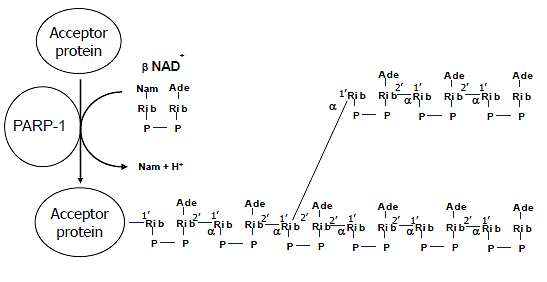PolyADP-ribosylation and cell proliferation

Date
Location
Description
Dear All,
Cell Signal Unit (Yamamoto Unit) would like to inform you of a seminar by Dr. Masanao Miwa from Nagahama Institute of Bio-Science and Technology.
-----------------------------------------------------------
Date: Wednesday, February 7, 2018
Time: 14:00-15:00
Venue: C016, Level C, Lab 1
-----------------------------------------------------------
Speaker:
Dr. Masanao Miwa, Nagahama Institute of Bio-Science and Technology
Title:
PolyADP-ribosylation and cell proliferation
Abstract:
PolyADP-ribosylation is one of the posttranslational modifications and is suggested to be involved in various biological functions including DNA repair, chromatin stability, transcription, cell transformation, and cell death.
PolyADP-ribosylation reaction is the dynamic modification of acceptor proteins with a long polymer of poly(ADP-ribose), which is synthesized by poly(ADP-ribose) polymerase (PARP). Recently an inhibitor of PARP, Olaparib (Lynparza), has been approved as therapeutics by FDA (U.S.A.) for advanced ovarian cancer and for germline BRCA-mutated metastatic breast cancer. In Japan Olaparib tablets were approved on 19 January, 2018, as maintenance treatment for women with platinum-sensitive relapsed ovarian cancer regardless of BRCA mutation status.
We have been studying the biological functions of polyADP-ribosylation and recently found an interesting relationship between polyADP-ribosylation and cell proliferation using a sensitive ELISA system (1) to measure physiological level of rapidly metabolizing poly(ADP-ribose). The study clarified that the physiological level of poly(ADP-ribose), which had been difficult to quantify until recently, is highest in the early S phase of HeLa cells in culture, and Olaparib and 3-aminobenzamide, the inhibitors of PARP, delayed the cell cycle significantly.
We previously found that the inhibitors of PARP induce centrosome amplification, with or without DNA damaging agents, and suppression of centrosome amplification after DNA damage depends on p27 (Kip1) accumulation (2).
I am happy to discuss the mechanism with you.
1. Ida C et al. An enzyme-linked immunosorbent assay-based system for determining the physiological level of poly(ADP-ribose) in cultured cells. Anal Biochem 494:76-81, 2016.
2. Suppression of centrosome amplification after DNA damage depends on p27 accumulation. Sugihara E et al. Cancer Res 66: 4020-4029, 2006.
Host:
Prof. Tadashi Yamamoto
We hope to see many of you at the seminar.
Best regards,
Yuki Nakagawa
Research Unit Administrator
Cell Signal Unit
Subscribe to the OIST Calendar: Right-click to download, then open in your calendar application.



